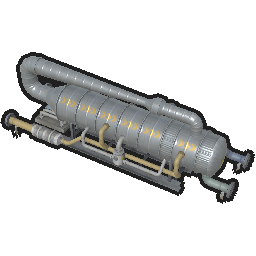Difference between revisions of "Thermal Desalinator"
Thadius856 (talk | contribs) m (→�: +{{recipe fetch|isbldg=yes}}) |
|||
| Line 5: | Line 5: | ||
{{Machine Recipe | {{Machine Recipe | ||
| Input1Name = Construction Parts III | | Input1Name = Construction Parts III | ||
| Input1Qty = | | Input1Qty = 23 | ||
| Input2Name = Steel | | Input2Name = Steel | ||
| Input2Qty = | | Input2Qty = 23 | ||
}} | }} | ||
| Workers = 4 | | Workers = 4 | ||
| Electricity = | | Electricity = 40 KW | ||
| Maintenance = 2 | | Maintenance = 2 | ||
| Footprint = 11x4 | | Footprint = 11x4 | ||
| Line 21: | Line 21: | ||
The Brine byproduct can be utilized in [[Electrolyzers]] to create {{infoicon|Chlorine}} to treat {{infoicon|Waste Water}} or in fed into [[Wastewater Treatment]] machines to convert {{infoicon|Toxic Slurry}} into {{infoicon|Slag}}. The [[Evaporation Pond]] and [[Evaporation Pond (Heated)]] can also process Brine into Salt, however due to the greatly elevated {{infoicon|Electricity}} requirements of Thermal Desalinators, production of Salt from Seawater is several times more energy efficient. | The Brine byproduct can be utilized in [[Electrolyzers]] to create {{infoicon|Chlorine}} to treat {{infoicon|Waste Water}} or in fed into [[Wastewater Treatment]] machines to convert {{infoicon|Toxic Slurry}} into {{infoicon|Slag}}. The [[Evaporation Pond]] and [[Evaporation Pond (Heated)]] can also process Brine into Salt, however due to the greatly elevated {{infoicon|Electricity}} requirements of Thermal Desalinators, production of Salt from Seawater is several times more energy efficient. | ||
==Recipes== | == Recipes == | ||
{{recipe define | {{recipe define | ||
| Input1Name = Seawater | | Input1Name = Seawater | ||
| Input1Qty = 10 | | Input1Qty = 10 | ||
| Input2Name = Steam Hi | | Input2Name = Steam Hi | ||
| Input2Qty = | | Input2Qty = 2 | ||
| Time = 10 | | Time = 10 | ||
| Output1Name = Water | | Output1Name = Water | ||
| Output1Qty = | | Output1Qty = 8 | ||
| Output2Name = Brine | | Output2Name = Brine | ||
| Output2Qty = 4 | | Output2Qty = 4 | ||
| Line 35: | Line 35: | ||
{{recipe define | {{recipe define | ||
| Input1Name = Seawater | | Input1Name = Seawater | ||
| Input1Qty = | | Input1Qty = 7 | ||
| Input2Name = Steam | | Input2Name = Steam Lo | ||
| Input2Qty = | | Input2Qty = 4 | ||
| Time = 20 | | Time = 20 | ||
| Output1Name = Water | | Output1Name = Water | ||
| Output1Qty = | | Output1Qty = 8 | ||
| Output2Name = Brine | | Output2Name = Brine | ||
| Output2Qty = | | Output2Qty = 3 | ||
}} | }} | ||
{{recipe define | {{recipe define | ||
| Input1Name = Seawater | | Input1Name = Seawater | ||
| Input1Qty = | | Input1Qty = 4 | ||
| Input2Name = Steam Depleted | | Input2Name = Steam Depleted | ||
| Input2Qty = 8 | | Input2Qty = 8 | ||
| Time = 40 | | Time = 40 | ||
| Output1Name = Water | | Output1Name = Water | ||
| Output1Qty = | | Output1Qty = 10 | ||
| Output2Name = Brine | | Output2Name = Brine | ||
| Output2Qty = | | Output2Qty = 2 | ||
}} | }} | ||
{{recipe fetch|isbldg=yes}} | {{recipe fetch|isbldg=yes}} | ||
{{Navbox/Machines}} | {{Navbox/Machines}} | ||
Revision as of 21:55, 9 June 2022

| Construction | |
| Workers | |
| Electricity | |
| Maintenance | |
| Footprint | 11x4 |
| Required Research | Thermal Desalination |
| Designation | Water Extraction & Processing |
The Thermal Desalinator is a machine which converts Seawater and either Steam (High), Steam (Low), or Steam Depleted into Water and Brine. Due to its high Electricity costs, it is vastly more efficient to utilize alternate sources of Water, such as Groundwater Pumps if there is a sufficient supply of rainfall to replenish groundwater aquifers or a Groundwater Well if one has been discovered/repaired.
The Brine byproduct can be utilized in Electrolyzers to create Chlorine to treat Waste Water or in fed into Wastewater Treatment machines to convert Toxic Slurry into Slag. The Evaporation Pond and Evaporation Pond (Heated) can also process Brine into Salt, however due to the greatly elevated Electricity requirements of Thermal Desalinators, production of Salt from Seawater is several times more energy efficient.
Recipes
| |
| |
| Planned or Proposed | |
| * Only available in the Supporter Edition | |